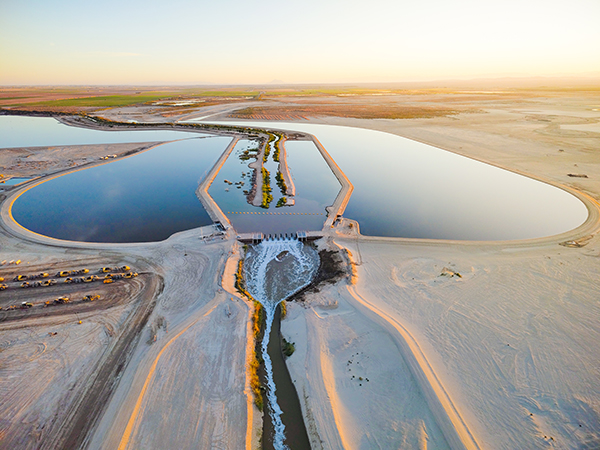
Salton Sea Species Conservation Habitat Project
Client
California Department of Water Resources / Kiewit Infrastructure West Co.Location
California, USAHighlights
- Civil and structural design
- Mechanical design
- Hydrologic analyses
- Hydraulic modelling and design (river and pond hydraulics, effluent mixing)
- Geotechnical investigations and design
- Habitat restoration design

Overview
The Salton Sea Species Conservation Habitat Project is a large-scale environmental restoration initiative aimed at addressing critical issues surrounding California's largest lake. The Salton Sea, a landlocked saltwater lake situated approximately 250 feet below sea level, has been shrinking for decades due to reduced inflows and increased evaporation. This shrinkage has exposed large areas of lakebed, leading to significant environmental and health concerns.
The project developed a 4,000-acre wetland habitat to mitigate the effects of the shrinking sea, including:
- Creating a more sustainable aquatic ecosystem to counter hypersaline water conditions that have become inhospitable to most aquatic species. The lake is currently over 50% saltier than the Pacific Ocean, and as it continues to recede, salinity is projected to further increase to over 300 g/L within 15 years.
- Restoring lost aquatic and terrestrial habitats to rebuild the food chain, addressing disruptions that have severely impacted local and migratory bird species that frequent the area.
- Suppressing dust and reducing airborne particulates from wind-blown, very fine-grained exposed lakebed sediments. The improved air quality helps mitigate health risks for Imperial Valley residents, who suffer from asthma rates several times higher than the regional average.
- Constructing a visitors’ center, enhancing public awareness and engagement about the long-term plan to continue restoring these important shoreline habitats.
The Challenge
The shrinkage of the Salton Sea, due to decades of reduced inflows and increased evaporation, has exposed large areas of lakebed, leading to significant environmental and health concerns. The main challenge was to develop a solution that could create a sustainable aquatic ecosystem, restore lost habitats, suppress dust, and improve air quality in the face of increasing salinity and limited water resources. While addressing these issues, the team needed to overcome complex geotechnical conditions, including construction on exposed lakebed sediments in a high seismic area with liquifiable foundation materials, and designing facilities for a highly saline environment.
The California Department of Water Resources (DWR) initiated the project after conducting extensive studies to identify economically and technically viable solutions. Knight Piésold partnered with Kiewit Infrastructure West Co. (Kiewit), and the team was selected as the preferred EPC bidder by DWR, based on the team’s conceptual design that demonstrated innovative and practical solutions.
Our Approach
The Knight Piésold-Kiewit team designed an innovative gravity-flow system for the project to achieve efficient water management and habitat creation. This approach is more robust and energy-efficient than the original pumping system concept, resulting in significant operational cost savings.
Key features include:
- Specialized diversion structure with a labyrinth weir for effective freshwater diversion from the New River
- Mixing channels and sedimentation ponds for optimal water quality control, maintaining salinity between 20 g/L and 40 g/L
- Variable speed pumps and removable diffuser pipes for flexible salinity management
- Habitat pond isolation for independent operation, maintenance, and testing of different island habitats
- Flood Buffer Zone for flow attenuation and habitat protection
- Seismic-resistant design balancing safety and cost-effectiveness
The project encompasses three habitat ponds and a Flood Buffer Zone, covering over 4,000 acres. Detailed hydraulic modeling was required to meet the depth, velocity, and flow distribution patterns in the habitat ponds.
Innovative construction methods were employed to overcome challenging site conditions:
- Over 17 miles of earthen berms built on soft lakebed sediments using specialized designs
- Thicker earthfill lifts and seepage mitigation for stable foundations
- Offshore pump station with a mile-long causeway constructed using local materials
The design incorporates climate change considerations, including measures to handle high-intensity rainfall events. The labyrinth weir allows flood passage while minimizing upstream impacts, protecting agricultural lands.
The Results
The Knight Piésold-Kiewit team’s final design met or exceeded all prescribed performance criteria and client expectations. The project, completed within the allotted budget and schedule, provides over 4,000 acres of aquatic and terrestrial habitats, where endangered species are now flourishing, migratory birds have returned in greater numbers, fish populations are recovering, and native vegetation is thriving once again. This proof-of-concept project has resulted in a toolbox of cost-effective construction methods that will be carried forward through future restoration projects. Ongoing expansion projects will add an additional 7,800 acres of habitat.
Awards
- Environmental Award, 2025 Canadian Consulting Engineering Awards
- Award of Excellence, Water Resources Category, 2025 Canadian Consulting Engineering Awards
- Award of Excellence, Natural Resource & Habitat Category, 2025 ACEC-BC Awards for Engineering Excellence